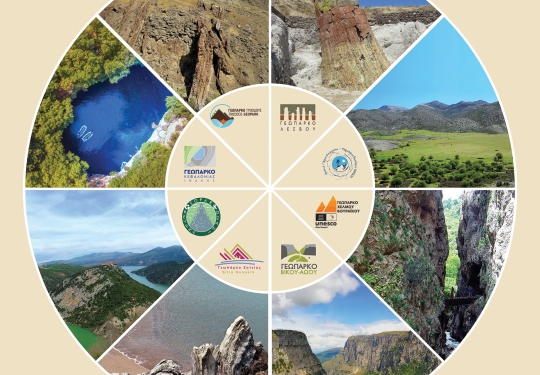"AEGEAN - CREATION OF AN ARCHIPELAGO"
When and how were the Aegean Sea and its islands created?

Exhibition Photos
Other Exhibitions
Offering unique collections and a variety of activities and events, the Natural History Museum of the Lesvos Petrified Forest is always ready to welcome its visitors.
Discovering the Lesvos Petrified Forest, a unique natural monument, is an unforgettable experience.
The Natural History Museum of the Lesvos Petrified Forest is a place of education, knowledge and inspiration. Following the current theory and practices of Museum Education, it designs and implements educational programs for students of all levels of education, children of all ages and families.
The Museum operates the Lesvos Geopark and collaborates with many cultural, educational, research organizations and Museums. It is a founding member of the European and Global Geoparks Network, pioneered in the establishment of the network of the Museums of Lesvos, collaborates with schools and Environmental Education Centers, as well as with a significant number of research centers and universities in the framework of research activities.
The Natural History Museum of the Lesvos Petrified Forest (Greek: Μουσείο Φυσικής Ιστορίας Απολιθωμένου Δάσους Λέσβου) is a geological museum located in the village of Sigri on the island of Lesbos in Greece. Established in 1994, it is a center for the study, management, and preservation of the petrified forest of Lesbos and for public education about the site. It is a founding member of the European Geoparks Network and is a member of UNESCO's Global Geoparks Network.
The exhibition was organized by the Natural History Museum of the Lesvos Petrified Forest in collaboration with the Universities of Thessaloniki, Aegean and Crete and with the support of TETRAGON. To date, the exhibition has been presented in Thessaloniki, Athens, Rome, Moscow and Chicago.
When and how were the Aegean Sea and its islands created? Are there active volcanoes in Greece? Has our country always had its Mediterranean climate? What kind of animals and plants have lived in our area in the past? How are the Cyclops connected to the geological history of the Aegean?
You can find the answers to these and many more questions at the temporary exhibition “Aegean-Creation of An Archipelago”.
Through impressive fossils and rocks of the Natural History Museum of the Lesvos Petrified Forest, the Museum of Geology and Paleontology of the Aristotle University of Thessaloniki and the Natural History Museum of the University of Crete, rich photographic material, audiovisual representations, projections and interactive applications, the geological processes that shaped the Aegean for the last 250 million years, as well as its ecosystems, are being presented.
The exhibition consists of three sections. The first, “GAIA MEMORIES: from Tethys to Aegean”, presents the entire geological history of the region, from the original ocean of Tethys to the shaping of the contemporary Greek archipelago. The section “To the islands of Hephaestus and Poseidon” illustrates the geodynamic processes in the Aegean, the volcanic and seismic activity that formed the Archipelago. The third section, “GAIA: from myth to science”, presents the impressive evolution of the biodiversity of the Aegean basin over the course of 150 million years.
The exhibition invites us to get to know the Archipelago of nature and culture, myths and history, to understand the constant interaction of geology and culture, while at the same time it stimulates our senses with images from the islands of the Aegean Sea.
Exhibition Photos
Other Exhibitions
Monday -Sunday: 9.00-17.00
Sigri, Lesvos island, P.C. - 81103
+30 22530 54434
lesvospf@otenet.gr


